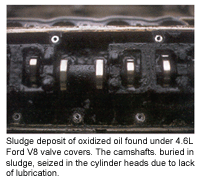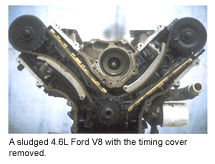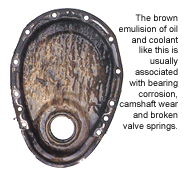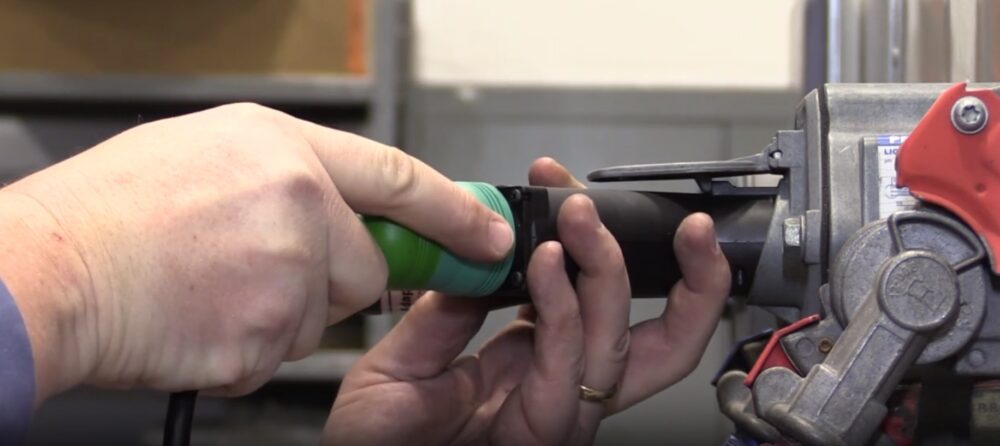Fresh engine oil is a clear, free-flowing liquid blend of base stock and additives that contains no fuel, water, coolant, dirt or other contaminants. In engines that have failed prematurely, the oil has very often been transformed into a high viscosity deposit of brown or black goo, commonly referred to as “sludge.”
When regular engine oil changes are neglected, normally free-flowing lubricating oil breaks down, becomes contaminated, ceases to flow and is transformed into a thick soup of waste products. That’s when serious engine damage is imminent.
Why does engine oil break down, combine with contaminants and form sludge deposits? Chemistry teaches us that engine oil is unstable and decomposes in the presence of oxygen at high temperatures. The process, called oxidation, occurs naturally after exposure to normal operating conditions for extended periods of time and is accelerated by exposure to severe operating conditions or to excessively high temperatures. Alternatively, accelerated oxidation may be triggered by a combination of any or all of these factors.
 During oxidation, the chemical bonds that define the oil molecules are broken and some of the reaction products accumulate and interact to form a highly viscous complex mixture of solids, liquids and gases that contain a variety of solid carbon-based dirt and metallic particles, as well as liquid coolant, fuel, oil and water droplets.
During oxidation, the chemical bonds that define the oil molecules are broken and some of the reaction products accumulate and interact to form a highly viscous complex mixture of solids, liquids and gases that contain a variety of solid carbon-based dirt and metallic particles, as well as liquid coolant, fuel, oil and water droplets.
But what can technicians possibly learn from a sludged engine? Consider our reliable 40-year-old 10-hp shop compressor that has delivered zillions of cubic feet of pressurized air daily from its ambient temperature shelter. While the electric motor and the V-belts have been replaced twice, the only other routine service this air-cooled V4 compressor has received, other than having the condensed water drained from the tank, is an occasional oil change. When the used, unfiltered HD-30 oil is drained from its crankcase, it shows no evidence of contamination or oxidation and looks like fresh oil.
A typical internal combustion engine is just an air compressor in which fuel is mixed with compressed air and then burned. The combustion process generates heat and a variety of reaction products, some of which enter the crankcase as blowby and contaminate the oil, e.g., fuel, soot, water and other normal reactants, products and byproducts.
Even though the oil temperature is high enough to boil off and extract all the water and other volatile contaminants via the PCV system, this crankcase broth will inevitably change into a deposit that does not drain when the oil is changed. Air-cooled gas or diesel engines are just air compressors in which the engine oil is subject to oxidation because they are exposed to higher temperatures and contamination by combustion products. If the engine is liquid-cooled, the engine oil may also become contaminated with coolant.
The following are some diagnostic solutions to oil sludge in your customers’ engines.
Lesson #1
Sludge deposits in internal combustion engines can indicate either stop-and-go driving, lack of proper maintenance, too low or too high an oil temperature or oil contamination.
 Sludge formation is not a new problem. In fact, sludge deposits limited the durability of early internal combustion engines. Over the years, oil-based stocks were improved, detergent oil additives were developed to keep microscopic sludge-forming solid particles in suspension, anti-oxidation additives were developed to slow the formation of these sludge deposit precursors and engine oil filters were fitted to remove suspended solid particles from the oil stream and slow the formation of flow-restricting sludge deposits on internal surfaces.
Sludge formation is not a new problem. In fact, sludge deposits limited the durability of early internal combustion engines. Over the years, oil-based stocks were improved, detergent oil additives were developed to keep microscopic sludge-forming solid particles in suspension, anti-oxidation additives were developed to slow the formation of these sludge deposit precursors and engine oil filters were fitted to remove suspended solid particles from the oil stream and slow the formation of flow-restricting sludge deposits on internal surfaces.
Changes in engine oil formulation and treatment accelerated with the introduction of “permanent” glycol-based coolant, another oil contaminant that may accelerate sludge formation. With the recent increased popularity of wet-sleeved engines, as well as the introduction of alternative but incompatible coolants, we are seeing more engine bearing failures.
Lesson #2
Sludge deposits may be due to inferior oil, deterioration of the oil additives or contamination by coolant.
When “detergent oils” first appeared, everyone’s engine repair business increased. Tired, worn-out engines, full of sludge deposits because they had always been serviced with non-detergent oils, were ill advisedly transfused with detergent oil, which promptly attacked the sludge deposits. Engine bearing surfaces were flooded with oil containing a high concentration of newly suspended sludge particles. And during the phase-in of detergent engine oils, a number of chemical elixirs for “engine oil desludging” appeared. With current engines, we often encounter similar failures when engines are accidentally overfilled and loosen normally benign engine deposits. Unless you’re very young or your principal residence is a cave, none of this should be news.

Lesson #3
Absence of sludge deposits may indicate the crankcase has been “flushed,” especially if fresh oil contains an excessive concentration of solids.
Some years ago we sold some oil, a filter and a pan gasket for a 366 truck engine to a customer who initially was asked to do a routine oil change. He eventually had to remove the oil pan because the engine oil had thickened and would not flow out of the drain hole. Once he removed the pan bolts, the oil pan, which was very heavy because it was full of thick black goo, fell to the floor. The individual who was previously contracted to “service” this fleet vehicle had repeatedly neglected to drain the old oil when he changed the filter and topped up the level of the used oil. Exposed to heat for an extended period of time, the old oil eventually oxidized and transformed into a black mass resembling thick molasses or Le Brea tar pits’ crude.
Lesson #4
Always be suspicious of maintenance information.
Today, we see a lot of sludged engines because of two different factors, the trend to ever-higher engine oil temperatures (oil coolers help) and the tendency to neglect or postpone routine maintenance, especially in the case of leased vehicles. When a yuppie BMW owner volunteered that his “Service Engine” light was designed to indicate when he should add some engine oil, I suggested that he might want to change it to read: “Too Late.” Engine noises and low oil pressure are obvious indications of inadequate engine bearing lubrication. So, when oil sludge is found, overextended drain intervals, elevated oil temperatures and/or contamination should be considered as the most likely causes. But there are always exceptions.
Experienced engine technicians understand that all sludge deposits are not necessarily due to abuse and neglect. When we find a lot of sludge in an engine, we always try to pinpoint the cause(s), do what we can to avoid a repeat occurrence and advise the customer or an engine installer how to minimize engine sludge formation.


